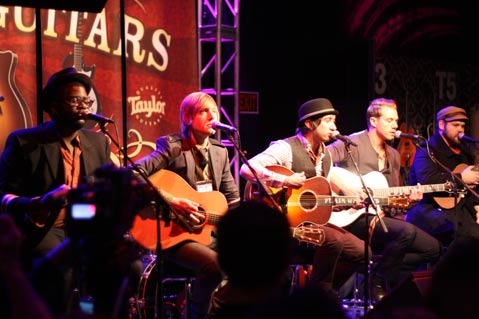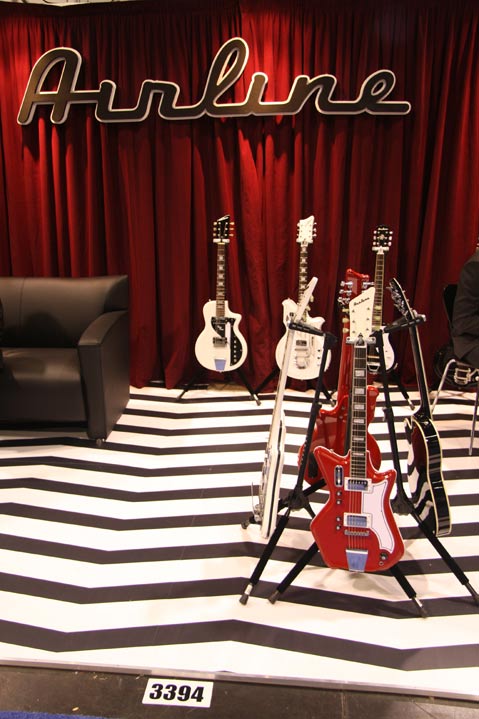Doing NAMM, on the Five-Hour Historical Tour Plan

NAMM REPORT: Ostensibly, this not-so-little thing called NAMM is all about nuts-and-bolts and bottom dollars, in and around the business and machinery of music. After all, the mammoth show, tell and sell expo – which packs the vast Anaheim Convention Center each January and pulls in thousands of visitors and exhibitors from around the world—is the showcase occasion for members of the National Association of Music Merchants. Biz is in the air. Every music manufacturer or connected business worth its salt shows up, and the population of visitors ranges from retailers to rock ‘n’ rollers, software nerds to acoustic guitar bohemians, and neatly-dressed piano salesfolk to scantily-clad cheesecake models (thank you, Dean Guitars, for making the world safe for shameless Convention culture kitsch).
But, of course, there’s much more involved. The NAMM show also lures in a brotherhood/sisterhood of people passionate about the tools of the musical trade under one humungous roof—quite beyond the biz buzz. And for observers of musical evolution, and journalists who may also be closet musician gear geeks, NAMM also serves as a remarkable, if half-accidental, portal into the wild evolutionary history of musical equipment and the spirit of invention over the past century, and more.
That ulterior identity became clear when we made the annual NAMM pilgrimage last week. We started our mad five-hour tour of the show (two days is preferable) downstairs in the funkier bargain basement hall below the larger exhibition halls upstairs. Down here, some of the quirkier and humbler exhibitors show their wares, including a new company called Ampkit, which uses the iPad (a tool of increasing use to resourceful musicians) to offer a guitarist a wide array of simulated amplifier sounds, at the tap of an app. Just down the aisle, a slice of “ancient” history could be found in a booth advertising the 30th anniversary model of the once-celebrated and now Fairlight CMI synthesizer, which, along with the Synclavier, was a pioneering ‘80s-era synthesizer of visionary capabilities and arm-and-a-leg price points. If dog years are roughly one-to-seven human years, evolution in electronic music compared to conventional, old school instruments must be around one-to-ten years. Just a thought.

Nearby, purely physical, pneumatics-controlled automation was on display at the Ragtime booth, with wild multi-instrument contraptions were physically triggered into playing goofy arrangements of “Stairway to Heaven” and more classical etudes. The get-ups are akin to those of Pat Metheny’s “Orchestrion” project (Metheny himself played the company’s guitar component), as heard, seen and barely believed in Campbell Hall last year.
History comes in different flavors and meanings, of course, in music and its instrumental makers, refiners and re-inventors. One of the cherished and most venerable of American instrument companies is Martin Guitars, founded by C.F. Martin back in 1833 and still a paradigm of fine acoustic guitar crafting. On a local note, Martin’s rather subdued booth this year was overshadowed by a younger upstart across the aisle, the Goleta-based Seymour Duncan’s bigger, better and more flamboyant 35th anniversary booth.
Many in Santa Barbara can say we knew him when, and now. Duncan, of course, is Santa Barbara’s claim to fame in the instrumental merchandise world, whose internationally-famed and incurably hip custom guitar pick-up operation has made him a household name wherever fine guitars are sold or chattered about. What began as a humble operation on Santa Barbara’s eastside, where Duncan would tinker with new pickup ideas, talk with any and all customers, is now a huge business, with a factory in Goleta, run by the founder’s ex-wife and company-builder, Cathy Duncan.
Each year, bless its creative heart, Seymour Duncan cooks up some new theme for its NAMM booth, and this year’s model outdid itself, with large drooping sheer fabric swooping down from on high and a general design based around a psychedelic ‘60s club or hookah hangout, minus the hookahs. It made sense, given Duncan’s friendship with Jeff Beck, Jimi Hendrix, and other rock icons. Behind a long bar in the booth, an exotic assortment of guitar and bass pickups replaced exotic liquor bottles, and table tents advertised pickups instead of imbibe-ables or buffalo wings. Today, the company still sells pickups –for electric, acoustic and bass guitars–as its meat-and-potatoes product, but also amplifiers and retro-flecked effects foot pedals, all on display at NAMM courtesy a rotating roster of nimble guitarists on stage in the microcosmic booth/hang zone.
That inevitable fatigue feeling of NCS (NAMM Crash Syndrome) was starting to set in a bit by the time we were escalated to the upper conventional center hall, just in time to cool ears and feet a bit at the Taylor Guitar booth. In this comfortable self-enclosed space, m&ms are served amidst the warm, wood-lined guitar garden, and noted musicians tend to play on the fully-equipped stage. Take, for instance, the agreeable popster band Plain White T’s (“Hey Hey Delilah”), making a friendly noise in unplugged mode.
Over in the room for that other American guitar classic, Fender, the history-hopping theme of NAMM continued, apace. Apart from vintage models of Telecasters and Stratocasters, and latter-day facsimiles of vintage models, the company is excitedly releasing a new product, Squire guitars—with actual strings!—for use in the computer game sensation, Rock Band. It’s the next best thing to being there, and actually playing music oneself. And when our sons and daughters, and the children within us, decide to take up the Real Thing, they may well find themselves craving a trip to the NAMM show. It comes with the territory.
TO-DOINGS: Oddly enough, this week features some enticing offerings of orchestra music from that great and under-sung era, the twentieth century. The Santa Barbara Symphony, joined by the State Street Ballet, will present a grand song-and-dance version of Aaron Copland’s greatest hit, the Appalachian Spring suite, at the Granada this weekend, on a program also featuring Stravinsky’s always ear-pleasing neo-classical classic, Pulcinella Suite, along with Schubert’s luminous Fifth Symphony. Next up, Monday’s CAMA-sponsored concert by the wonderful Los Angeles Chamber Orchestra, led by guest conductor/pianist Ignat Solzhenitsyn, mixes up the real classical sounds of Mozart and Haydn with Polish great Witold Lutoslawski’s paean to Bartók, Musique funèbre (“Funeral Music”). In short, the Granada will come alive with sounds of the past century this week, for a change.
Fans of so-called “world music” (forgive the potentially ethnocentric moniker) know to keep watch over the calendar at UCSB’s MultiCultural Center, which presents several concerts from various global corners each year. This year’s season begins this Saturday with a sound that should be—and probably is–more familiar than it seems, as the Los Angeles-based band Buyepongo cooks up its seductive variation on the great style of cumbia.



